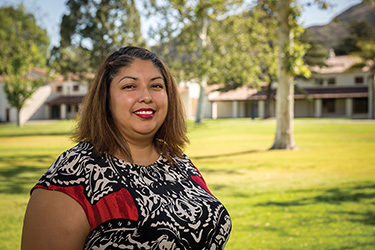From Agricultural Labor to Academia
By Marya Jones Barlow
A migrant farmworker throughout her teenage years and early adulthood, Nava is now on a far different path. At the age of 37, she’s a first-generation college graduate poised to enter a competitive Ph.D. program in Chemistry at the University of Northern Texas this fall. Each time Katia Garcia Nava passes workers in the agricultural fields on the way to CI’s campus, she reflects with amazement on how far she has come and where she is headed.
“It has taken me 19 hard years to get here, but giving up was never an option,” she said. “If I had not attended CI, I probably would have dropped out of school by now. I think I would have been completely lost at another campus, but the professors here saw my potential and believed in me enough to care and support me. I have gained wonderful mentors for life.”
Nava was born in Yuba City, the oldest daughter in a family of five children. Her parents, migrant farmworkers from Mexico, moved frequently following seasonal crops. Nava and her siblings bounced from school to school and spent summers helping in the fields.
“The lack of stability resulted in holes in my education,” she said. “Also, as the oldest daughter, I was given more family responsibilities, resulting in less time for school. On the other hand, my childhood taught me how to be responsible and be a hard worker. It also made me realize that this was not something I wanted to do for the rest of my life. I wanted more. I wanted an education—even more education than my parents hoped for me.”
After graduating from high school, Nava enrolled in college several times over the years, but ended up dropping out or failing classes because she was working to support her family.
“At times, I would go years without enrolling,” she said. “It wasn’t that my parents made me do it, but rather that I would see them struggle financially and realize that my siblings would suffer, so I worked to make sure they would be taken care of.”
Finally, at the height of the economic recession in 2008, she resolved to get her degree no matter what. Despite dealing with the aftereffects of a debilitating car accident, financial hardships, and the illnesses and deaths of family members, Nava continued to work various jobs and plug away at her education.
At CI, Nava’s professors recognized a promising student and offered her guidance and encouragement—not just to complete her bachelor’s degree, but also to go on to graduate school. As a participant in CI’s Project ACCESO and Louise Stokes Alliance for Minority Participation (LSAMP) programs, which promote Science, Technology, Engineering and Mathematics (STEM) opportunities for students from challenged backgrounds, she found Chemistry more intriguing than intimidating.
“Katia’s perseverance and tenacity are nothing short of awe-inspiring. She doesn’t realize how special she is,” said CI Math Professor Cindy Wyels, who knows Nava well through her roles as Director of LSAMP and Co-Director of Student Success for Project ACCESO. “Fewer than 20 percent of underrepresented minorities transfer from community to college to a four-year university. Yet here’s Katia, a native Spanish speaker with no educated people around her, who would not take ‘no’ for an answer. She would not let barriers hold her back and struggled mightily to be where she is today.”
Nava has volunteered for programs encouraging students of all ages to pursue science careers—mentoring children in CI’s Migrant Summer Leadership Institute, doing K-12 STEM outreach through Project ACCESO, and tutoring college students in science and math.
After earning her Ph.D. from the University of Northern Texas, Nava hopes to educate the next generation of college Chemistry students.
“I would love to be given the opportunity to teach so that I can inspire confidence in those who think a Chemistry major is impossible,” she said. “My motivation is my nieces and nephews. The new generation needs more role models and more women in science.”
Return to the Table of Contents© Spring 2014 / Volume 18 / Number 1
